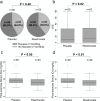Risedronate prevents exercise-induced hypercalcemia but not nausea or vomit in humans: a double blind randomized controlled trial
- PMID: 39341930
- PMCID: PMC11439016
- DOI: 10.1038/s41598-024-73985-6
Risedronate prevents exercise-induced hypercalcemia but not nausea or vomit in humans: a double blind randomized controlled trial
Abstract
Reportedly, nausea or vomiting after heavy exercise was associated with post-exercise increased blood calcium (Ca) levels, which was correlated with enhanced bone resorption. We conducted a randomized, double-blind, placebo-controlled trial, enrolling 104 healthy trained male members of the Japan Ground Self-Defense Forces. Risedronate (17.5 mg) or placebo was prescribed 3 and 10 days before heavy exercise lasting approximately 5 h. The primary outcome was the severity of nausea or vomiting assessed by a visual analog scale during or post-exercise. The secondary outcomes included clinical symptoms associated with heat illness, post-exercise serum total Ca (tCa), whole blood ionized Ca (iCa), and serum tartrate-resistant acid phosphatase 5b (TRACP-5b) levels. The mean age was 26 years. The exercise resulted in a 4.5% weight loss. The two groups were comparable in terms of the symptoms, including primary outcome. However, post-exercise tCa and TRACP-5b were significantly lower with risedronate. A similar result was observed for iCa. The post-exercise urinary Ca/Magnesium ratio and the incidence of hypercalcemia (defined as tCa or iCa levels ≥ each median value of all subjects) were significantly lower with risedronate (78.0% vs. 58.5%). A stronger treatment effect of risedronate on blood Ca levels was observed in participants who lost substantial body weight. Post-exercise hypercalcemia is attributed to enhanced bone resorption but not the cause of nausea.
© 2024. The Author(s).
Conflict of interest statement
The authors declare no competing interests.
Figures




Similar articles
-
Exercise-induced hypercalcemia and vasopressin-mediated bone resorption.Osteoporos Int. 2021 Dec;32(12):2533-2541. doi: 10.1007/s00198-021-06030-1. Epub 2021 Jun 17. Osteoporos Int. 2021. PMID: 34137899
-
Effects of risedronate 5 mg/d on bone mineral density and bone turnover markers in late-postmenopausal women with osteopenia: a multinational, 24-month, randomized, double-blind, placebo-controlled, parallel-group, phase III trial.Clin Ther. 2007 Sep;29(9):1937-49. doi: 10.1016/j.clinthera.2007.09.017. Clin Ther. 2007. PMID: 18035193 Clinical Trial.
-
Modeling and simulation of bone mineral density in Japanese osteoporosis patients treated with zoledronic acid using tartrate-resistant acid phosphatase 5b, a bone resorption marker.Osteoporos Int. 2018 May;29(5):1155-1163. doi: 10.1007/s00198-018-4376-1. Epub 2018 Feb 8. Osteoporos Int. 2018. PMID: 29423715 Free PMC article. Clinical Trial.
-
Oral risedronate increases Gruen zone bone mineral density after primary total hip arthroplasty: a meta-analysis.J Orthop Surg Res. 2018 Jun 7;13(1):144. doi: 10.1186/s13018-018-0794-1. J Orthop Surg Res. 2018. PMID: 29880021 Free PMC article. Review.
-
Efficacy of risedronate in improving bone mineral density in patients undergoing total hip arthroplasty: A meta-analysis of randomized controlled trials.Medicine (Baltimore). 2018 Dec;97(51):e13346. doi: 10.1097/MD.0000000000013346. Medicine (Baltimore). 2018. PMID: 30572438 Free PMC article.
References
-
- Costa, R. J. S., Snipe, R. M. J., Kitic, C. M. & Gibson, P. R. Systematic review: Exercise-induced gastrointestinal syndrome—implications for health and intestinal disease. Aliment. Pharmacol. Ther. 46, 246–265 (2017). - PubMed
-
- Senda, M. et al. Exercise-induced hypercalcemia and vasopressin-mediated bone resorption. Osteoporos. Int. 32, 2533–2541 (2021). - PubMed
-
- Ruben, J. A. & Bennett, A. F. Intense exercise, bone structure and blood calcium levels in vertebrates. Nature 291, 411–413 (1981). - PubMed
-
- Aloia, J. F., Rasulo, P., Deftos, L. J., Vaswani, A. & Yeh, J. K. Exercise-induced hypercalcemia and the calciotropic hormones. J. Lab. Clin. Med. 106, 229–232 (1985). - PubMed
-
- Convertino, V. A., Morey, E. R. & Greenleaf, J. E. Reduction in plasma calcium during exercise in man. Nature 299, 658 (1982). - PubMed
Publication types
MeSH terms
Substances
LinkOut - more resources
Full Text Sources
Medical
Miscellaneous

